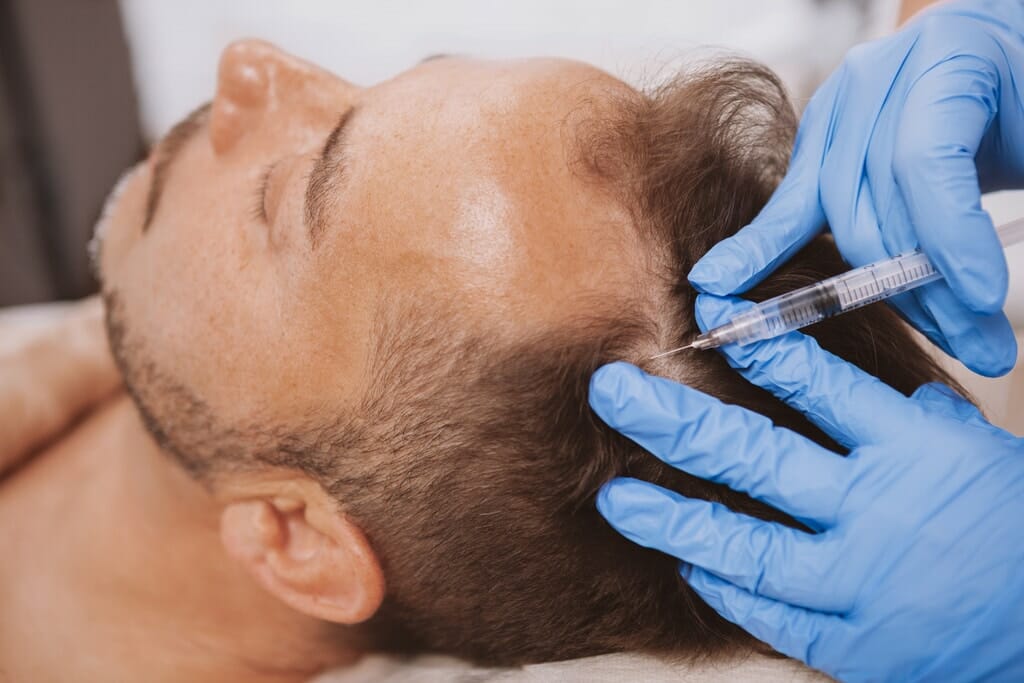Hair loss is a common condition that impacts many people, regardless of their gender. It can be caused by several different factors such as genetics, hormonal changes, medical conditions and lifestyle choices.
Being such a prevalent condition, the search for hair restoration techniques is often a big part of the hair loss journey. These can include various treatment options, including both topical and oral medications, as well as hair transplants.
However, some techniques can also be regenerative, potentially harnessing and amplifying the body’s ability to heal itself to stimulate hair growth. The most common example of this is platelet-rich plasma (PRP) injections – a technique that can be used in combination with hair transplantation to maximise results.
What is PRP therapy?
PRP therapy is based on the regenerative properties associated with platelets – small, disc-shaped cells found in the blood that play a crucial role in healing.1
When tissue damage occurs, platelets become activated and release various proteins and growth factors to support repair and regeneration. Growth factors like platelet-derived growth factor, transforming growth factor-beta and insulin-like growth factor, for example, all help stimulate the replication of the cells involved in tissue repair.
PRP therapy involves factors that stimulate the formation of new blood vessels (angiogenesis) to boost circulation and supply oxygen and nutrients to the regenerating tissues. It also helps stimulate the production of collagen and uses various anti-inflammatory cytokines to reduce inflammation and create a healthy environment for healing.2
Research has found that PRP can be especially beneficial when used in areas of medicine like:
- Orthopaedics
- Dermatology
- Dentistry
- Cosmetic procedures
- Sexual health
- Cardiology
- Eye surgery
- Hair restoration3
How does PRP work?
Since PRP therapy relies on using your plasma, collecting a blood sample is the first step.
This sample will contain various components, such as red blood cells, white blood cells, plasma and platelets, which will then need to be separated based on their densities via a centrifuge machine.
Spinning the blood sample at a high speed allows the heavier red blood cells to separate from the plasma, suspending the platelets. This then allows the platelets and growth factors to be concentrated into a smaller volume of plasma, thus creating platelet-rich plasma.4
This can then be injected into any desired areas via PRP therapy to promote regeneration.

PRP for hair loss
Within the context of hair loss, PRP injections can be used to stimulate the hair follicles, improve overall hair health and reduce hair loss.
They can enhance the healing process – a potential benefit when recovering from a hair transplant in terms of protecting the graft and reducing the risk of shock loss.
For both of these reasons, PRP can be used alongside a hair transplant procedure to help solidify and enhance hair regrowth.
PRP therapy procedure
Here is a step-by-step breakdown of what to expect during a PRP procedure for hair loss.5
Step 1: Consultation
First, a consultation will take place with a hair restoration specialist. During this consultation, they will assess your medical history, current health and the type of hair loss you have to determine whether PRP therapy is right for you.
Step 2: Blood collection
If PRP is deemed a suitable option for you, the next step will involve collecting some blood. A small sample of blood will be drawn from your arm and then used to create the PRP solution.
Step 3: Centrifugation
This blood sample will then be placed into the centrifuge machine to separate the platelets and growth factors from the other components contained within your blood.
Step 4: PRP preparation
Next, the PRP solution will be prepared for use during the procedure. Before the procedure begins, your scalp will be cleaned and potentially numbed with a local anaesthetic to minimise any pain.
Step 5: The PRP procedure
Using a fine needle, the PRP solution will be injected directly into your scalp in any areas of hair loss or thinning. The injections will be strategically placed to cover as much of the affected area as possible.
Step 6: Follow-up sessions
PRP therapy can involve a series of sessions, depending on your body’s response to the treatment and the severity of your hair loss. Initially, treatments can be every 3 months, before moving to every 6 months to maintain your regrowth.
PRP treatment benefits
PRP therapy can offer a number of benefits in terms of hair restoration, especially when used alongside a hair transplant. Some of these main benefits include:
- Improved healing – PRP can accelerate tissue repair and regeneration, so recovery from a hair transplant can be faster.
- Reduced downtime – a faster recovery means you can get back to daily life much quicker.
- Enhanced graft survival in transplants – while it’s normal for some transplanted hairs to fall out during recovery, PRP be used to ensure they grow and develop as they should.
- Improved nutrient supply – PRP therapy provides your scalp with an improved blood supply which will increase the number of nutrients it receives. This can then promote hair health and regrowth.
- Reduced inflammation – inflammation is common after a hair transplant, so using PRP therapy to reduce it can aid your recovery.
- Better tissue regeneration – the growth factors in PRP therapy stimulate the regeneration of tissue within the scalp, speeding up recovery and promoting healthy growth.
- Improved follicular health – PRP can be used to revive dormant hair follicles by providing them with the nutrients they need. This can boost hair growth and make the regrowth thicker and stronger.6
Many of these benefits can also be experienced without the need for a hair transplant. The improved nutrient supply to your hair follicles, for instance, could help promote stronger hair regrowth.
Recovery and results
Recovering from a session of PRP therapy will take around one week and will often involve some discomfort being felt at the site of the injections.
During this time, it’s important to avoid strenuous activities and avoid using topical hair treatments/products.
If you have had PRP therapy alongside a hair transplant, this shouldn’t change your aftercare or recovery.
In the first week, scabbing will likely appear at the site of the grafts. These will then fall off within the next two weeks.
New hair growth will also start to appear anywhere between three and six months after the hair transplant procedure.
Everybody is different and, for some people, they may see results sooner than others. It’s important to remain patient while awaiting your results, allowing enough time for the PRP therapy to boost your hair growth and follicular strength.
Book a consultation with The Treatment Rooms London
If you’re considering treating your hair loss, take the first step towards hair regrowth by booking a consultation with The Treatment Rooms London.
Our experienced team can guide you through the process and create a personalised treatment plan around your exact needs. Simply contact us to get started.
Sources
- Paichitrojjana A, Paichitrojjana A. Platelet Rich Plasma and Its Use in Hair Regrowth: A Review. Drug Des Devel Ther. 2022 Mar 10;16:635-645. doi: 10.2147/DDDT.S356858. PMID: 35300222; PMCID: PMC8922312. Available at: https://www.ncbi.nlm.nih.gov/pmc/articles/PMC8922312/
- Paichitrojjana A, Paichitrojjana A. Platelet Rich Plasma and Its Use in Hair Regrowth: A Review. Drug Des Devel Ther. 2022 Mar 10;16:635-645. doi: 10.2147/DDDT.S356858. PMID: 35300222; PMCID: PMC8922312. Available at: https://www.ncbi.nlm.nih.gov/pmc/articles/PMC8922312/
- Cole BJ, Seroyer ST, Filardo G, Bajaj S, Fortier LA. Platelet-rich plasma: where are we now and where are we going? Sports Health. 2010 May;2(3):203-10. doi: 10.1177/1941738110366385. PMID: 23015939; PMCID: PMC3445108. Accessed August 2023
- Paichitrojjana A, Paichitrojjana A. Platelet Rich Plasma and Its Use in Hair Regrowth: A Review. Drug Des Devel Ther. 2022 Mar 10;16:635-645. doi: 10.2147/DDDT.S356858. PMID: 35300222; PMCID: PMC8922312. Available at: https://www.ncbi.nlm.nih.gov/pmc/articles/PMC8922312/
- Healthline, PRP For Hair Loss, Accessed August 2023. Available at: https://www.healthline.com/health/prp-for-hair-loss
- Paichitrojjana A, Paichitrojjana A. Platelet Rich Plasma and Its Use in Hair Regrowth: A Review. Drug Des Devel Ther. 2022 Mar 10;16:635-645. doi: 10.2147/DDDT.S356858. PMID: 35300222; PMCID: PMC8922312. Available at: https://www.ncbi.nlm.nih.gov/pmc/articles/PMC8922312/
Share:
Authored by
Reviewed by
Book a Consultation
Related Blogs
Ariana Grande Hair Loss: Prevention, Styling Secrets, and Hypothetical Transplant Solutions
April 10, 2025
Ariana Grande, the global pop sensation renowned for her signature high ponytail and bold hairstyles, has openly…
Daniel Craig Hair Transplant: Before, After and His Hairline
April 10, 2025
Daniel Craig, the world-famous English actor who gained international fame as the fast-paced, debonair James Bond, has…
Rob Brydon Hair Transplant: Before, After, and His New Hairline
April 8, 2025
Rob Brydon, the beloved Welsh comedian and Gavin & Stacey star, has traded his receding hairline for…











